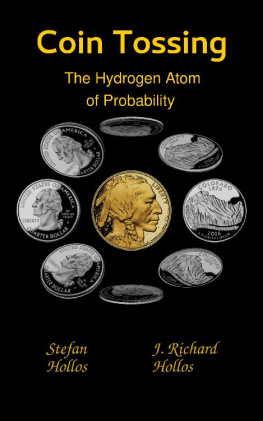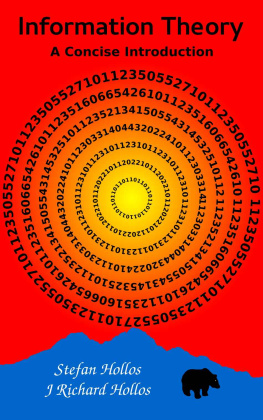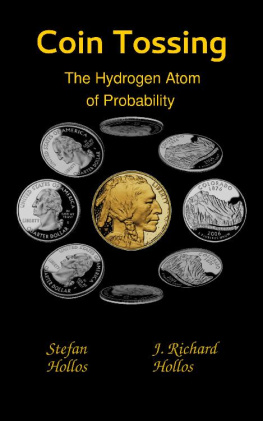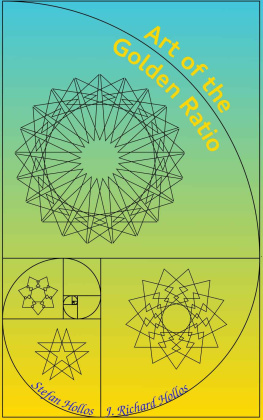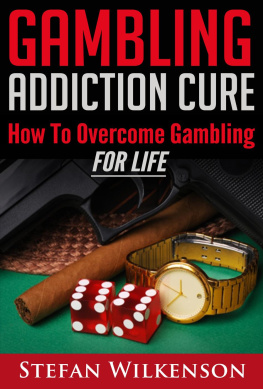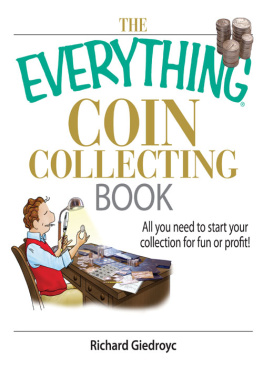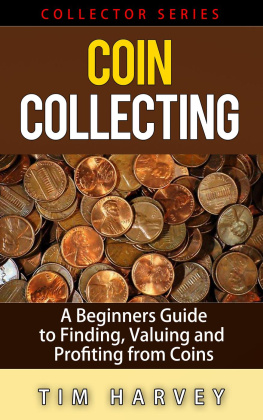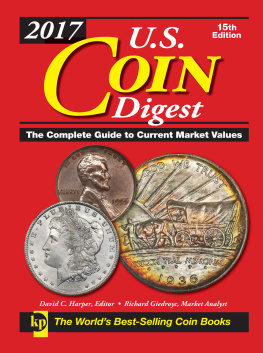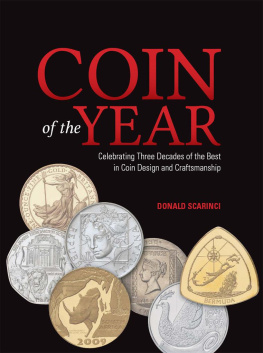Stefan Hollos - Coin Tossing
Here you can read online Stefan Hollos - Coin Tossing full text of the book (entire story) in english for free. Download pdf and epub, get meaning, cover and reviews about this ebook. year: 2019, publisher: Abrazol, genre: Children. Description of the work, (preface) as well as reviews are available. Best literature library LitArk.com created for fans of good reading and offers a wide selection of genres:
Romance novel
Science fiction
Adventure
Detective
Science
History
Home and family
Prose
Art
Politics
Computer
Non-fiction
Religion
Business
Children
Humor
Choose a favorite category and find really read worthwhile books. Enjoy immersion in the world of imagination, feel the emotions of the characters or learn something new for yourself, make an fascinating discovery.
- Book:Coin Tossing
- Author:
- Publisher:Abrazol
- Genre:
- Year:2019
- Rating:4 / 5
- Favourites:Add to favourites
- Your mark:
- 80
- 1
- 2
- 3
- 4
- 5
Coin Tossing: summary, description and annotation
We offer to read an annotation, description, summary or preface (depends on what the author of the book "Coin Tossing" wrote himself). If you haven't found the necessary information about the book — write in the comments, we will try to find it.
Coin Tossing — read online for free the complete book (whole text) full work
Below is the text of the book, divided by pages. System saving the place of the last page read, allows you to conveniently read the book "Coin Tossing" online for free, without having to search again every time where you left off. Put a bookmark, and you can go to the page where you finished reading at any time.
Font size:
Interval:
Bookmark:
Coin Tossing: The Hydrogen Atom of Probability
Stefan Hollos and J. Richard Hollos
Published by Abrazol Publishing, 2019.
While every precaution has been taken in the preparation of this book, the publisher assumes no responsibility for errors or omissions, or for damages resulting from the use of the information contained herein.
COIN TOSSING: THE HYDROGEN ATOM OF PROBABILITY
First edition. July 5, 2019.
Copyright 2019 Stefan Hollos and J. Richard Hollos.
ISBN: 978-1887187398
Written by Stefan Hollos and J. Richard Hollos.
10 9 8 7 6 5 4 3 2 1
Coin Tossing: The Hydrogen Atom of Probability
by Stefan Hollos and J. Richard Hollos
Copyright 2019 by Exstrom Laboratories LLC
All rights reserved. No part of this document may be reproduced or transmitted in any form or by any means, electronic or mechanical, including photocopying, recording, or by any information storage and retrieval system, without permission in writing from the publisher.
Abrazol Publishing
an imprint of Exstrom Laboratories LLC
662 Nelson Park Drive, Longmont, CO 80503-7674 U.S.A.
Publishers Cataloging in Publication Data
Hollos, Stefan
Coin Tossing: The Hydrogen Atom of Probability / by Stefan Hollos and J. Richard Hollos
p. cm.
Includes bibliographical references.
Paper ISBN: 978-1-887187-38-1
Ebook ISBN: 978-1-887187-39-8
Library of Congress Control Number: 2019904573
1. Probabilities 2. Stochastic processes
I. Title. II. Hollos, Stefan.
QA274.H65 2019
519.2 HOL
2010 Mathematics Subject Classification. Primary 60-01, 62-01
About the Cover: Coin images from the United States Mint.
This book is an expansion of the first edition of our Coin Toss book (The Coin Toss: Probabilities and Patterns), which was published only as an ebook, and released in September 2012, almost 7 years ago. Actually, the initial title was The Coin Toss: The Hydrogen Atom of Probability, which we soon thereafter changed because we thought the allusion to physics would be too esoteric for most readers. But we have since come around to the idea that the initial title was the better choice.
The big difference between this and the first edition is chapter 8 on run distributions. The chapter now has an extensive discussion of statistics on the number of runs in a binary sequence generated by fair coins, biased coins and binary Markov processes. It also looks at statistics for the number of runs of a given length. We also show how to find probability generating functions and expectations for the length of the longest run in a binary sequence. Another feature of this new edition is a chapter containing 26 problems and solutions.
The book contains material for both the beginning student and the advanced researcher. We suspect that the beginner will find some of the material quite difficult and not accessible on a first reading. This is a book that needs to be read more than once. There is more material here than anyone could absorb on a first reading. We hope that researchers on the other hand find the book to be a valuable reference and a stimulus for new research.
Most physicists would probably agree that quantum mechanics could never have been discovered without the hydrogen atom. The hydrogen atom is the simplest of all the elements with just one electron surrounding a nucleus composed of just one proton (there are two other forms of hydrogen that have neutrons in the nucleus). This simple arrangement gives hydrogen a clean emissions spectrum which allowed physicists to find formulas for the emission lines. Eventually Niels Bohr (1885-1962) came up with a model explaining the emission lines and the formulas. The model was developed further by other physicists and eventually evolved into what we now call quantum mechanics. Being able to start with the simple structure of the hydrogen atom is what made this all possible.
The coin toss is to probability theory what the hydrogen atom is to quantum mechanics. It is the simplest random event that you can imagine. There are only two possible outcomes: heads or tails. This simplicity means that many questions about coin tossing can be asked and answered in great depth. The simplicity also opens the road to more advanced probability theories dealing with events with an infinite number of possible outcomes. Without the example of simple random events like tossing coins or rolling dice it is very likely that probability theory would have taken much longer to develop. Indeed the beginnings of mathematical probability theory are usually traced to the analysis of a dice game by Blaise Pascal (1623-1662) and Pierre de Fermat (1607-1665) in the mid-seventeenth century. The roll of a die is very similar to the toss of a coin except that there are 6 possible outcomes instead of only 2. Most of the things that we will talk about concerning coins can be easily extended to dice.
Keep in mind as you read what follows, that the coin toss is really just a metaphor for a random event that has only two possible outcomes. The actual tossing of a real coin is just one way to realize such an event. There are many examples of things that are equivalent to a coin toss:
Will the stock market close up or down tomorrow?
Will a dice roll come up with an even or odd number?
Will we make contact with extraterrestrials within the next ten years?
Will the Denver Broncos win their next game?
Will a car drive by in the next minute?
Will the Republican or Democratic candidate win the next election?
Will tomorrow be sunny or cloudy?
Will tomorrow be warmer than today?
Will my medical test result be negative or positive?
Will I enjoy this movie?
Will the next joke be funny?
Will the Earths average temperature go up next year?
You can probably think of hundreds of other examples.
In the rest of this introduction we will take a detailed look at what happens when you toss a coin multiple times. This will lead in the next chapter to the subject of probability distributions that are associated with tossing a coin. We will show how many of the questions that can be asked about coin tossing are answered by specific distributions. The following chapter discusses some strategies for betting on coin toss games. The next chapter introduces the random walk interpretation of a series of coin tosses, and how the gamblers ruin problem can be viewed as a random walk with absorbing boundaries. This is followed by a chapter on runs and patterns in a sequence of coin tosses. The statistics of runs and patterns is useful for playing games where at least some aspect of the game can be modeled as a coin toss. Some forms of investing and trading fall in this category. Runs and patterns also come up in areas like reliability analysis and testing for defects in a manufacturing process. The next chapter shows how runs and patterns can be analyzed as Markov chains which is a very powerful technique that can be used to look at patterns of arbitrary complexity. We end with a chapter on the probability distribution for the longest run, followed by an appendix that reviews discrete probability.
So lets start by asking what happens when you toss a coin multiple times. If you toss a coin n times how many different strings of heads and tails can you get? For one toss you get H or T. Two tosses gives you TT, TH, HT, or HH. Every additional toss doubles the number of possible strings. So for
Font size:
Interval:
Bookmark:
Similar books «Coin Tossing»
Look at similar books to Coin Tossing. We have selected literature similar in name and meaning in the hope of providing readers with more options to find new, interesting, not yet read works.
Discussion, reviews of the book Coin Tossing and just readers' own opinions. Leave your comments, write what you think about the work, its meaning or the main characters. Specify what exactly you liked and what you didn't like, and why you think so.

